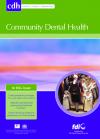Community Dental Health

- Cover Date:
- September 2006
- Print ISSN:
- 0265 539X
- Vol:
- 23
- Issue:
- 3
Abstracts - The 11th Annual Conference of The European Association of Dental Public Health
Abstracts - The 11th Annual Conference of The European Association of Dental Public Health, 7-9 September, 2006, Praque, Czech Republic: Scientific Abstracts
Session 1 – Oral Epidemiology – Congress Hall Friday 8 September 2006. Chairs: Professor Eino Honkala and Professor Neda Markovska
Trends in oral health and treatment need among children and adolescents. Z BROUKAL1*, R IVANCAKOVA2, E LENCOVA1, L MRKLAS1. 1Institute of Dental Research, 1st Faculty of Medicine, 2Faculty of Medicine, Hradec Kralove, Charles University in Prague, Czech Republic Surveys of oral health status and treatment need of selected age categories of Czech children and adolescents have been conducted approximately every three years since 1994 with the latest survey in 2004. Aim To ascertain the trends in oral health and treatment need by comparing caries experience, dental status and treatment need from four consecutive surveys in the past ten years. Methods In each survey, dental practitioners in randomly selected areas have examined approximately 20,000 individuals aged 5, 12, 15 and 18 years. The data were entered into standard WHO dental records. The areas included in the surveys have been the same throughout the ten-year-period. For each survey, the mean values have been calculated for the following parameters of oral health and treatment need: % caries-free (5-year-olds), dmft/DMFT, dt/DT (5, 12, 15 and 18-year-olds), and % in need of restorative care (dt/DT>0) (5, 12, 15 and 18year-olds). For assessing possible trends, regression lines were plotted for the individual parameter values stemming from the four consecutive surveys. Student’s t-tests were used for evaluating the statistical signiï¬cance of the regression coefï¬cients with the threshold for signiï¬cance set at p<0.05. Results 5-year-olds: Percentage of cariesfree 23.9, 24.7, 29.8 and 41.6 (ns) for 1994, 1997, 2000 and 2004, respectively. Mean DMFT: 12-year-olds 3.1, 3.2, 3.1 and 3.0 (ns), 15-year olds 5.8, 5.6, 5.4 and 5.2 (p<0.05), 18-year-olds 8.4, 7.8, 7.4 and 7.0 (p<0.05). Mean dt/DT: 5-year-olds 2.2, 2.2, 1.9 and 1.5 (p<0.05), 12-year-olds 0.8, 0.8, 0.9 and 0.8 (ns), 15-year-olds 1.2, 1.1, 1.2 and 1.3 (ns), 18-year-olds 2.1, 1.8, 1.5 and 1.3 (p<0.05). Percentage in need of restorative care: 5-yearolds 63.9, 61.1, 53.5 and 46.0 (p<0.05); 12-year-olds 43.4, 39.8, 33.9 and 28.5 (p<0.05); 15-year-olds 53.2, 52.2, 51.6 and 50.4 (ns); 18-year-olds - 68.5, 63.3, 59.3 and 57.7 (p<0.05). Conclusions Between 1994 and 2004: caries experience declined in 15- and 18-year-olds but not in 5- and 12-year-olds; mean dt/DT decreased in 5- and 18-year-olds but not in 12- and 15-year-olds; percentage of subjects in need of restorative treatment declined in 5-, 12- and 18-year-olds but not in 15-year-olds. Irrespective of some partial improvement it can be stated that the current preventive and restorative care are not effective enough to cope with the caries situation among the Czech children and adolescents. Acknowledgements: This study was supported by a grant of the Grant Agency of the Ministry of Health No: NR/8331-3. Oral health among 5-year-old children in Slovak Republic. Z VESELINYOVÃ*, N MARKOVSKà I. stomatologická klinika UPJÅ a FNLP, KoÅ¡ice, Slovak Republic Poor oral health is widely recognized as a problem that cannot be solved by means of dental care only. Family members and school teachers are also important. Slovakia is one of the countries that were not able to fulï¬l the WHO goals by the year 2000. WHO is collecting dental data from nearly 200 countries, mostly DMFT index values for 12-year-old children but in recent years increasingly also data on caries situation among the 5-year-olds. In Slovakia and Eastern European countries, preventive programmes are not fully established for the latter age group. Aim To determine the level of oral health among a group of 5-year-olds living in Slovak Republic. Methods In the years 2004-2005, we examined 137 children, 82 boys and 55 girls of whom 76 lived in the town of KoÅ¡ice and 61 in the neighbouring villages. In a clinical oral examination, dental caries and the level of oral hygiene were recorded. The parents of the children also answered a questionnaire that included questions about oral hygiene habits and the use of oral health services. Results Only 29% of the children were caries-free. The mean dmft score was 5.5 with untreated dentinal caries being the predominant component of the index score. The most affected teeth were molars. In a similar study in 1987, the mean dmft score had been 3.4. Visible dental plaque was found in 30% of the children. There were no statistically signiï¬cant differences between boys and girls or between children from the town and villages. The analysis of the questionnaire revealed that 35% of the children had not yet visited a dental ofï¬ce. It was also found that among the parents only 50% had visited the dental ofï¬ce regularly for prevention and only one third reported using dental floss or a mouthwash. Conclusions The study conï¬rmed the necessity of revitalizing the systematic dental care for preschool children and establishing functional health promotion programmes in schools in order to advise the children and their parents to adopt appropriate oral health habits. Caries frequency in 6- and 12-year-old children in central Poland. E JODKOWSKA*, J KEPA, K MALKIEWICZ. Department of Conservative Dentistry, Medical University of Warsaw, Poland
- Article Price
- £15.00
- Institution Article Price
- £
- Page Start
- 164
- Page End
- 192
- Authors
Articles from this issue
- Title
- Pg. Start
- Pg. End
- Equity in children’s utilization of dental services: effect of a children’s dental care programme
- 152
- 157
- The Japanese version of the Oral Health Impact Proï¬le (OHIP) – validation among young and middle-aged adults
- 158
- 163
